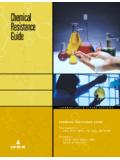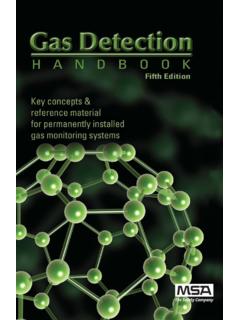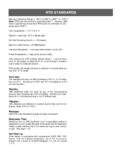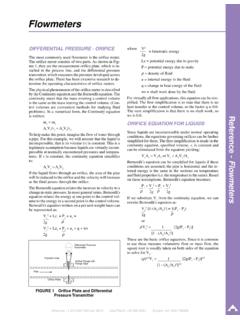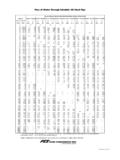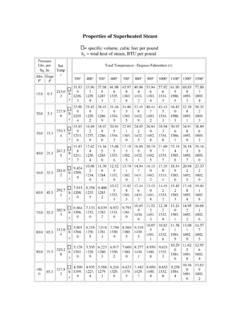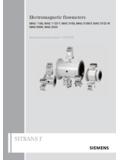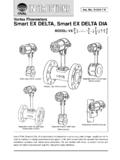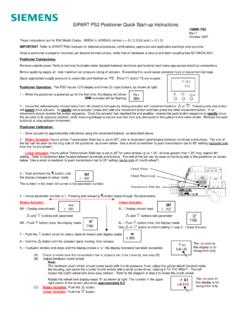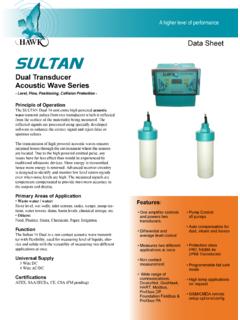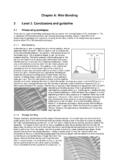Transcription of A Practical Overview of Level Measurement …
1 Drexelbrook Engineering CompanyPage 1 of 9A Practical Overview of Level Measurement TechnologiesMartin BahnerDirector of MarketingDrexelbrook Engineering Keith Valley , PA 19044 Abstract:There are multiple technologies available on the market to measure Level . Each and every technologyworks, when applied properly. This presentation will discuss the strengths and weaknesses of RFAdmittance, Capacitance, Ultrasonic, Radar, Nuclear, Differential Pressure, and Bubblers levelmeasurement Measurement for liquids, granulars, slurries and interfaces can be accomplished with severaldifferent Level technologies .
2 There are over 20 different technologies being offered on the market how would you know which technology to turn to for your application? Obviously all technologieshave (or had) their place, otherwise companies would not be in business today offering them. The truth isthat every technology for Level Measurement applied correctly (only used in the specificcircumstances where they have a high probability of success). This paper will discuss the most popularlevel Measurement technologies used in industry, outline their advantages and disadvantages, and tell youwhere they are best Application Box ScoreIncluded with the description of each technology is an application box score for the four categories of levelmeasurement (Liquids, Granulars, Slurries and Interfaces).
3 This gives you an at-a-glance Overview ofwhere the technology in question is best dark box indicates that this technology is suitable for this category of clear box indicates that this technology is not Practical for this category of levelmeasurement. This does not mean that people have not used this technology formeasurement, but just that it is not Practical . This could mean that there is excessive maintenance,excessive error, unreliable outputs, or it just simply doesn t work in this application based on thecharacteristics of the Level shaded box indicates that this technology can sometimes be applied to thisapplication.
4 But be careful. There are usually special considerations or additional maintenance : The Application Box Score above indicates that the technology in question works on needs special considerations or additional maintenance when used on slurries, and it is not Practical forgranulars or Engineering CompanyPage 2 of 9 Differential PressureTheoryPerhaps the most frequently used device for the Measurement oflevel is a differential pressure transmitter. This device does notreally measure Level . It measures the head pressure that thediaphragm senses due to the height of the material in the vesselmultiplied by a second variable, the density of the product.
5 Thisgives you the resultant force being exerted on the diaphragm,which is then translated into a Measurement of primary benefit of DP s is that it can be readily installed on a vessel. It can be easily removedusing block transmitters subject to errors due to density variations of the liquid. Density variations arecaused by temperature changes or change of product. These variations must always becompensated for if accurate measurements are to be made. DP s are primarily useful for cleanliquids. They require two tank entrances, one of which is near the bottom where leaks are mostproblematic.
6 D/P s should not be used with liquids that solidify as their concentrationsincrease. An example is paper pulp NotesFluid density must be stable if readings are to be accurate. A second d/p transmitter is requiredto measure density and then used to compensate for any changes. 2To accommodate themeasurement of light slurries, differential pressure transmitters are available with extendeddiaphragms that fit flush to the side of the vessel. However, certain materials which coat thediaphragm is in any way coated, it is subject to shifts in calibration and it can not be easilyremoved for , the measuring device is only one consideration in the total installation of the a D/P transmitter is often less expensive than other types of Level sensors, there isusually considerable additional hardware and labor required to make a Practical implementation of a stable.
7 Low pressure leg and 3 or 5 valve manifolds add considerablecost to the simple Level Measurement has a dip tube installedwith the open end close to the bottom of the processvessel. A flow of gas (usually air) passes through thetube and when air bubbles escape from the open end, theair pressure in the tube corresponds to the hydraulichead of the liquid in the vessel. The air pressure in thebubble pipe varies proportionally with the change inhead gaugeair inLiquidsGranularsSlurriesInterfacesDrex elbrook Engineering CompanyPage 3 of 9 AdvantagesSimplicity of design and low initial purchase cost are frequently given as advantages ofbubblers, but this is somewhat misleading.
8 The system consists of a pipe, an air supply, apressure transmitter and a differential pressure regulator. The regulator produces the constantgas flow required to prevent calibration is directly affected by changes in product density. It is frequently also necessary toperiodically clean this device. The tip of the pipe can collect material from the process, solidify,and plug the hole. Bubblers are not suitable for use in non-vented NotesAir lines should be heat-traced if freezing is possible. Calibrate at maximum temperature toavoid overfills. Accuracy depends on a stable air supply and is limited by the regulator, whichmay be + 10% of full scale.
9 In applications where the purge air is exposed to a hazardoussubstance, additional steps must be taken to contain any possible a body is immersed in a fluid, it loses weight equal to theliquid weight displaced (Archimedes Principle). By detection of theapparent weight of the immersed displacer, a Level instrument canbe devised. If the cross sectional area of the displacer and thedensity of the liquid is constant, then a unit change in Level willresult in a reproducible unit change in displacer well with clean liquids and are accurate and adaptable towide variations in fluid densities.
10 Once set up, however, the fluidsmeasured must maintain their are affected by changes in product density. Since the displacement of the body (it sweight loss) is equal to the weight of the fluid displaced. If the specific gravity changes, then theweight of the displaced material changes, thus changing the calibration. This is especiallyproblematic in interface measurements, where both liquids increase or decrease density, whilethe signal is proportional to the density the displacer is in the process fluid, solids can deposit on it. This changes the effectivedisplacement and causes a calibration are relatively expensive when placed in external cages.
